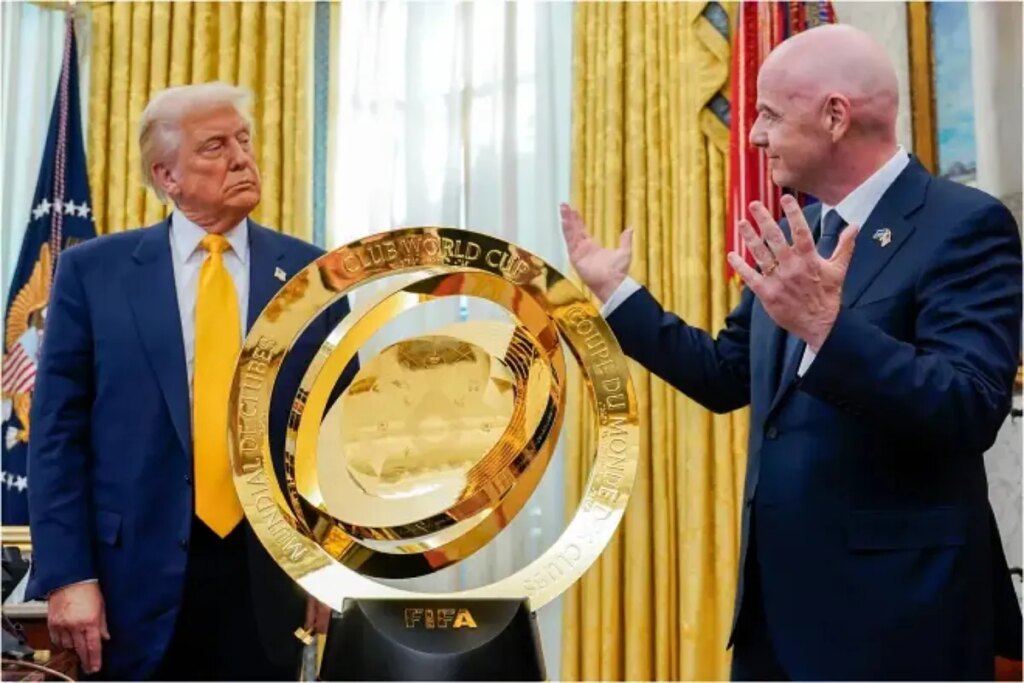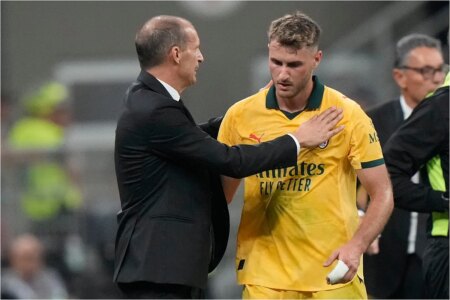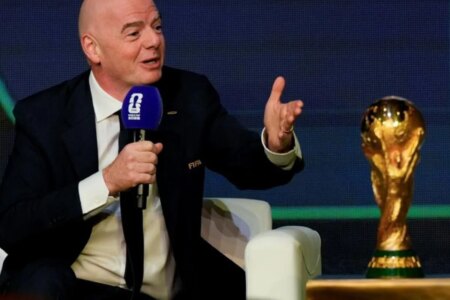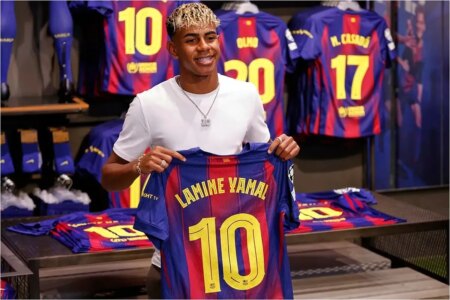Sixty days before its start, the new FIFA Club World Cup is already revolutionizing the sector through the announcement of prizes, sponsors and exposure for the organization and the clubs themselves. The opening match of what is being billed as the first ‘World Cup’ for clubs will be between Lionel Messi’s Inter Miami and Egypt’s Al Ahly. The match will be played on Saturday, June 14 in Miami. Among the main novelties already announced, one of them is the prizes. The champion will take home 125 million as a prize.
In the distribution of the money, the European teams will receive the highest amount, from 12.81 million to 38.19 million, followed by the South American teams with 15.21 million. That is to say, a country like Brazil and its soccer will receive 60 million, which is the money that Palmeiras, Flamengo, Fluminense and Botafogo will receive as a starting point. Next, teams from North, Central America and the Caribbean will receive 9.55 million each, the same amount as Asian and African teams, with 3.58 million for Oceania.
For Marcos Casseb, partner at Roc Nation Sports, the numbers prove FIFA’s interest in transforming the competition into a World Cup for national teams. “I think FIFA is interested in transforming this new World Cup model into a high-level global event, like the Champions League, increasing revenue and influence in club football, a sector historically dominated by UEFA,” he says. “This record prize serves as an incentive for participants, especially Europeans, to take this current format more seriously,” he adds. And the truth is that FIFA has sought to be above the Champions League.
The prizes far exceed those paid for the 2022 World Cup, which had a total prize pool of 440 million. This has to do with FIFA’s latest negotiations with sponsors, and the main one is related to the deal with DAZN, which has exclusive rights to free streaming of the matches, worth 1 billion. Prizes tend to increase as the platform can still license these rights in local markets. FIFA is reportedly hoping to reach 800 million with total broadcast sales.
The other four sponsorships signed by FIFA are Bank of America, considered one of the world’s leading banks, which is also one of the sponsors of the 2026 World Cup; the world’s largest brewery, AB InBev, which also owns well-known brands such as Budweiser and Michelob ULTRA; multinational beverage company Coca Cola, as well as Chinese electronics company Hisense.
Football ‘crosses the pond’
Over the next three years, starting in 2024, the United States will host some of the world’s major soccer competitions. In mid-2024, the starting point was the Copa America, which ended with Argentina as champion. In mid-2025, it will be the turn of the Club World Cup and in 2026, the World Cup, with some North American states as the main venues such as Canada and Mexico.
“Previously mentioned in the sporting world only by the NBA and the NFL, the United States is now experiencing a growing appreciation of soccer, driven in part by major events. It is an agenda that not only attracts international attention, but also catalyzes investment in infrastructure, media and advertising, as well as creating diverse business opportunities for the market, such as hospitality and offering a premium service to fans. FIFA’s move to Miami also reflects the long-term commitment to the growth of American soccer in the United States. Major U.S. leagues, such as the NFL and NBA, will continue to play a key role, but soccer is increasingly present in the country’s sporting life, and this is undeniable,” says Joaquim Lo Prete, national director of Absolut Sport in Brazil.
In the midst of all this, the main NBA and NFL games will continue to be held, further enlivening the daily life of these cities and consequently bringing joy to the tourists who will be there during these events.
FIFA Expansion
To get an idea of this expansion, FIFA has been moving its headquarters to Miami since 2023, taking into account the investments made by the country’s main league, Major League Soccer (MLS), especially after some stars went to the country, such as Lionel Messi and Luis Suarez to Inter Miami.
“We are witnessing the consolidation of the country in the world soccer scene. Due to the volume of investments in stadiums, clubs and the signing of high-level players, such as Lionel Messi, this was a natural path. Americans work with long-term plans, so it can be said that this is a construction that has been developing since the 1990s, when they hosted the 1994 World Cup.
Now the fruits are being reaped, with greater notoriety, brands, important sponsors and representation in the country. Before, soccer was just another sport, but today it is gaining more and more followers, especially in women’s soccer, a sport in which the country has been a reference for many years,” said Jorge Duarte, marketing and sports manager at Somos Young.
More than 100 employees of the world’s soccer governing body have moved from its headquarters in Switzerland to Coral Gables, where the organization’s legal, audit, compliance and risk management departments are located. With all this, could the United States be the new center of soccer? Sports management and marketing experts gave their opinions on the subject and presented their views from a business perspective.
Opportunity
“This is an unprecedented financial opportunity for Brazilian teams, with prizes equivalent to several sponsorships added up over the course of a year. This injection of resources can be decisive in balancing the books, reducing dependence on fluctuating income and even improving bargaining power with footballers wishing to sign. In addition to the direct impact on cash flow, the tournament increases global exposure, increasing market value and attractiveness to investors. While traditional sponsorships depend on performance and economic conditions, the World Cup’s fixed prize money offers a rare financial guarantee in modern football. For Brazilians, it’s not just about competing for a title, but about turning a single campaign into a lasting economic legacy,” said Thales Rangel Mafia, marketing director of Multimarcas Consorcios.
“The United States has been an important soccer hub for years. A solid and organized league that has become a destination not only for super footballers, but also for emerging talent from various countries around the world. Like everything they do in sport, these events will bring more audience to their products; I have no doubt that they will grow after this period. In addition, this move only makes everyone realize how professional they are and increases the interest of all those interested in being close to the US, footballers, sports professionals and the general public,” says Renê Salviano, CEO of Heatmap.
“I believe brands can make the most of the visibility and opportunities offered by major sporting events in the US ahead of the 2026 World Cup. By taking an integrated and creative approach, leveraging sponsorships, strategic partnerships, loyalty campaigns and interactive consumer experiences, brands can increase their visibility, build consumer loyalty and align with positive values, ensuring a lasting and meaningful impact,” said Wagner Leitzke, digital director at End to End agency.
“After several historical attempts to popularize soccer, the growing influence of Latin culture, the combination of hosting major events and having top stars playing in the local league has proven to be a winning recipe to change the importance of this sport in the most competitive market in the world,” says Ivan Martinho, professor of sports marketing at ESPM. “Competing for attention with the other four already established major leagues is quite a challenge, but soccer has everything it needs to cement its presence this time.”
For Fabio Wolff, managing partner of Wolff Sports, “it is still too early to say that the US is the new center of soccer.” According to him, “the country has tried several times to promote the growth of men’s soccer in American culture, but without much success.” Even so, it is undeniable to talk about everything the country can offer in terms of major events. The country is a sporting powerhouse, so it is natural that they want the world’s most important sport to grow there. Americans are very professional in terms of planning and organization, with a deeply rooted sporting culture.
Read the full article here











